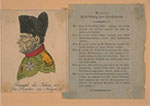
__________
-Based on Johann Michael Voltz-| Strictly speaking, this piece cannot be considered as a caricature but
rather as a particularly violent satirical print typical of the Germans. The print of
which several versions are listed, is associated with Franco-German explanations. The
drawing alludes to the battle of Leipzig, a genuine trap set out for Napoleon: the
Emperor's bust is composed of a map of Germany depicting the battles of the 1813
campaign, Lützen, Gros-Beeren, Hanau, and especially Leipzig. Napoleon is portrayed
as a true death-god whose face is composed of corpses. According to the text, the eagle
on top of his head which plays the part of a little hat, is the Prussian and not the
imperial eagle. The Emperor has definitely rushed into the German trap. The work aims at being mystical: it is clearly stated that God's hand rests on Napoleon's shoulder. The context is that of German romanticism, where budding nationalism is tinged with a sacred dimension. In fact, this print illustrates an idea which is typical of Germany at the time, as Hegel explained: first considered as the "soul of the world", Napoleon, having attempted to twist history in his favour, falls into Prussian hands. On July 5, 1816, the philosopher wrote to his friend Niethammer: « I strongly believe that the spirit of time is being ordered to go forward. This injunction is being obeyed.» It is exactly what is being pointed out by this caricature which goes beyond mere criticism of Napoleon (see N. Boussard, « Napoléon, héros hégélien », Souvenir napoléonien, March-April 1995, n° 400, p. 8-20) This work was based on a drawing by Johann-Michael Voltz. 20,000 copies were sold in Berlin in a week. It was issued throughout Europe as Broadley reminds us (from England to Italy, Russia, Holland, Sweden, Spain and Portugal). |
__________
-James Girtin-| Number 666 is that of the beast of the
Apocalypse. Through skillful calculation, the author of this ferocious attack against
Napoleon has managed to equate the Emperor with the horrific creature. Several writings
at the end of the Empire used the theme of the Antichrist, the Apollyon described by
Saint John. Thus from the name Apollyon one can easily switch to Napoleon. Therefore the
imperial epic was nothing but a war of cosmic extermination where, for a short while,
the beast, who had imprisoned the pope and usurped the sacred throne of the
Bourbons,triumphed on earth.
|
__________
-Louis-| This caricature is in fact a sequel to the print entitled Departure for the Army, which shows Napoleon riding a horse's skeleton and brandishing thunderbolts. Here, in a conversation with Death, the Emperor is explaining that he will sacrifice more young lives in its honour, to which Death replies: « Your turn shall come too. ». The theme of death had very seldom been used in caricature, that is, under this direct allegorical form. The devil taking Napoleon to hell was more frequently depicted. |
__________
-Lacroix-| The subject of this macabre dance is explained underneath the caricature's title. Here, full use is made of the allegory but not in its popular meaning, traditional to caricature. In fact, it rather refers to the great neo-classical culture of the time, and the drawing itself, with the exception of Napoleon, is under the influence of David's academicism. This influence is also clearly illustrated by the frieze arrangement of the characters. |
__________
| This two-faced caricature is known in Britain, France and Germany (see catal. exhib. Hanover, p. 178-179, n° 7.15, fig. LXI). Its meaning is a simple one: Napoleon is the devil. This print is not without reminding one of The Tyrant unmasked in which Napoleon unveils his tiger mask. |
__________
| This caricature dates back to the end of 1813 or the beginning of 1814. It was probably the first time the Emperor was likened to a goat, in other words to the devil. The print illustrates the Russian campaign from which a defeated Napoleon came back to Germany in order to attempt to resist the Allies. It is a call to eradicate the invader from the German soil in order to purge it of its hellish stain. |
__________
| This caricature is one of the internationalized prototypes. It is known in Britain (see J. Tulard, L’Anti-Napoléon, Paris, 1965) and in France (see C. Clerc, p. 164, n° 35). The model comes from Britain where it was published by Ackermann on March 18, 1814. In France and Germany, the subtitle, a parody of the biblical style, is the following: « Here is my beloved son who gave me so many satisfactions ». It is one of the prints in which Napoleon is the most effectively linked to the devil. |
Napoleon body and soul
Ideology
Great art
Popular culture
The exiled;